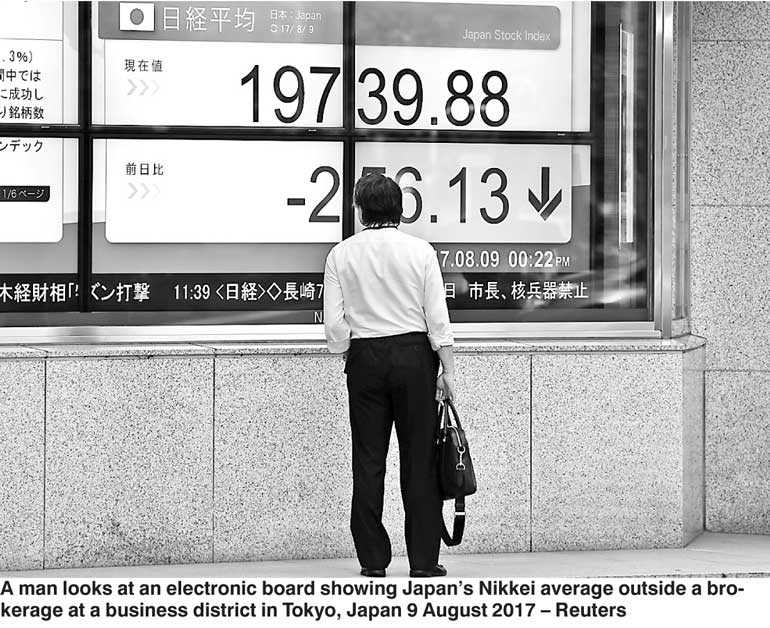Friday Mar 07, 2025
Friday Mar 07, 2025
Saturday, 23 June 2018 00:00 - - {{hitsCtrl.values.hits}}

TOKYO (Reuters): Asian shares stumbled to their lowest in six months on Friday, hurt by signs US trade battles with China and many other countries are starting to chip away at corporate profits, while oil prices were choppy before an OPEC meeting to discuss raising output.
MSCI’s broadest index of Asia-Pacific shares outside Japan dropped as much as 0.35% at one point to touch its weakest since early December before erasing losses to be up 0.15%. Still it was 2.3% off for the week.
Hong Kong’s Hang Seng plumbed six-month lows, having lost 3.9% so far this week. South Korea’s KOSPI hit nine-month lows and in mainland China, the CSI300 index lost almost 5% this week to one-year lows.
Japan’s Nikkei gave up 0.8% for a weekly loss of 1.7%.
European stock futures point to slightly firmer openings in Britain’s FTSE, France’s CAC and Germany’s DAX from multi-week lows hit the previous day.
On Wall Street, the Dow Jones Industrial Average fell for an eighth straight session on Thursday and the S&P 500 lost 0.63%, with industrials and materials shares taking a hard knock.
Even the high-flying Nasdaq Composite, which has outperformed this year on the perception that high-tech shares were less vulnerable to trade wars, shed 0.88%.
In a sign that escalating tensions between the United States and its trade partners were taking a toll on the economy, the Philadelphia Federal Reserve’s gauge of US Mid-Atlantic business activity fell to a 1-12 year low.
“The Philadelphia Fed’s survey showed a drop in new orders. Investors are concerned that the trade frictions are starting to affect corporate sentiment and their activities,” said Nobuhiko Kuramochi, chief strategist at Mizuho Securities.
The impact on corporate profits has become tangible, with German carmaker Daimler cutting its earnings forecast on Wednesday, saying tariffs on cars exported from the United States to China would hurt Mercedes-Benz sales.
Despite budding evidence of economic damage, trade frictions have shown no sign of abating.
US Commerce Secretary Wilbur Ross said on Thursday the United States needs to make it harder for its trading partners to have high trade barriers in order to achieve President Donald Trump’s ultimate goal of lower tariffs and a level playing field.
India joined the European Union and China in retaliating against Trump’s tariffs on steel and aluminium, raising import duties on US almonds by 20% and leveraging its position as the world’s biggest buyer of the product.
While some investors still hope Washington and Beijing can work out a deal before July 6, when the first round of US tariffs on Chinese goods as well as retaliatory tariffs by China are due to take effect, others see diminishing hopes of an early compromise.
Worsening sentiment pushed US bond yields lower and triggered profit-taking in the dollar.
The 10-year US Treasuries yield fell to 2.910% from Thursday’s high of 2.950% and its three-week high of 3.010% touched on Wednesday last week.
As the dollar lost steam, the euro bounced back to $1.1630 after hitting an 11-month low of $1.1508 on Thursday.
The single currency had fallen on bets of a protracted period of monetary policy divergence between the US Federal Reserve and the European Central Bank.
In addition, the Italian Government’s appointment on Thursday of two eurosceptics to head key finance committees reignited worries about anti-euro voices in the euro zone’s third-largest economy.
The British pound jumped back from a seven-month trough after the Bank of England’s chief economist, Andy Haldane, unexpectedly joined the minority of policymakers calling for rates to rise to 0.75%, citing concerns about growing wage pressure.
The pound last fetched $1.3270, off Thursday’s low of $1.3102.
The Chinese yuan weakened about 0.15% in both onshore and offshore trades, staying near their lowest levels since mid-January.
“If the US puts more pressure on China with tariffs, I would suspect the Chinese authorities would like to drive the yuan lower to mitigate the impact,” said Daisuke Uno, chief strategist at Sumitomo Mitsui Bank.
Oil prices rose on uncertainty ahead of a meeting of the Organization of Petroleum Exporting Countries (OPEC) and other major producers including Russia starting later on Friday.
Saudi Arabia and Russia have said a production increase of about 1 million barrels per day (bpd) or around 1 percent of global supply had become a near-consensus proposal for the group and its allies, but Iran held out against a deal amid the prospect of lower exports due to U.S. sanctions on Tehran.
Brent crude traded at $74.00 a barrel, up 95 cents, or 1.3%, a day after it had fallen $1.69.
US West Texas Intermediate crude rose 89 cents, or 1.35% to $66.42 per barrel.
Discover Kapruka, the leading online shopping platform in Sri Lanka, where you can conveniently send Gifts and Flowers to your loved ones for any event including Valentine ’s Day. Explore a wide range of popular Shopping Categories on Kapruka, including Toys, Groceries, Electronics, Birthday Cakes, Fruits, Chocolates, Flower Bouquets, Clothing, Watches, Lingerie, Gift Sets and Jewellery. Also if you’re interested in selling with Kapruka, Partner Central by Kapruka is the best solution to start with. Moreover, through Kapruka Global Shop, you can also enjoy the convenience of purchasing products from renowned platforms like Amazon and eBay and have them delivered to Sri Lanka.
Discover Kapruka, the leading online shopping platform in Sri Lanka, where you can conveniently send Gifts and Flowers to your loved ones for any event including Valentine ’s Day. Explore a wide range of popular Shopping Categories on Kapruka, including Toys, Groceries, Electronics, Birthday Cakes, Fruits, Chocolates, Flower Bouquets, Clothing, Watches, Lingerie, Gift Sets and Jewellery. Also if you’re interested in selling with Kapruka, Partner Central by Kapruka is the best solution to start with. Moreover, through Kapruka Global Shop, you can also enjoy the convenience of purchasing products from renowned platforms like Amazon and eBay and have them delivered to Sri Lanka.